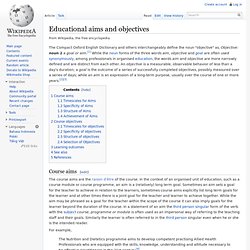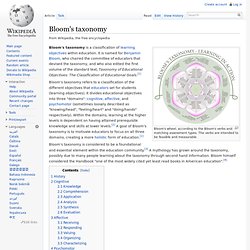

Educational aims and objectives. The Compact Oxford English Dictionary and others interchangeably define the noun "objective" as, Objective: noun 1 a goal or aim.[1] While the noun forms of the three words aim, objective and goal are often used synonymously, among professionals in organised education, the words aim and objective are more narrowly defined and are distinct from each other.

An objective is a measurable, observable behavior of less than a day's duration; a goal is the outcome of a series of successfully completed objectives, possibly measured over a series of days; while an aim is an expression of a long-term purpose, usually over the course of one or more years.[2][3] Course aims[edit] For example, The Nutrition and Dietetics programme aims to develop competent practising Allied Health Professionals who are equipped with the skills, knowledge, understanding and attitude necessary to be effective practitioners in the 21st century.[4] Timescales for Aims[edit] Specificity of Aims[edit] Structure of Aims[edit] Bloom's Taxonomy. Bloom's wheel, according to the Bloom's verbs and matching assessment types.

The verbs are intended to be feasible and measurable. Bloom's taxonomy is a classification of learning objectives within education. It is named for Benjamin Bloom, who chaired the committee of educators that devised the taxonomy, and who also edited the first volume of the standard text, Taxonomy of Educational Objectives: The Classification of Educational Goals. Bloom's taxonomy refers to a classification of the different objectives that educators set for students (learning objectives).
It divides educational objectives into three "domains": cognitive, affective, and psychomotor (sometimes loosely described as "knowing/head", "feeling/heart" and "doing/hands" respectively). Bloom's taxonomy is considered to be a foundational and essential element within the education community. History[edit] Who needs learning objectives? How many times have you embarked on some formal learning, whether in a classroom or through an elearning or blended course, and the first thing you’re presented with is a list of rather bland learning objectives?

This begs the question, are lists for losers? Charles Jennings considers the evidence. At the end of this course you will be able to tie your shoelaces in a double bowAt the end of this course you will be able to use a blender to make a tasty fish milkshakeAt the end of this course you will be able to make gold out of base metaland so on... Apart from being some of the most de-motivating writing any of us have ever read, lists of learning objectives are the worst possible way to create an environment for learning. In fact, they are often the first barrier to real learning. Two basic problems I see two basic underlying problems with learning objectives.
Secondly, many training and development specialists are learning obsessed rather than performance obsessed. A nod to Bloom. Learning Objectives: Stems and Samples. Writing Effective Learning Objectives. "Shoulds" of Learning Objectives. Learning Objectives. Quick Tips - Learning Objectives. Writing Learning Objectives:Beginning With The End In Mind.